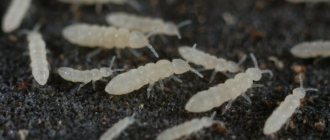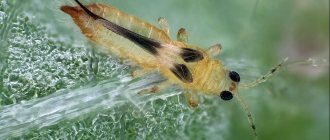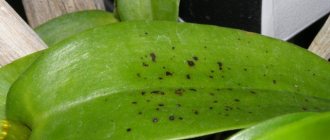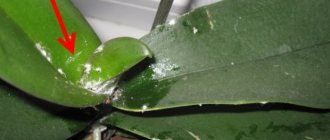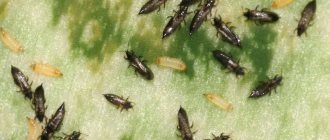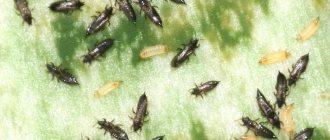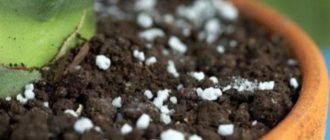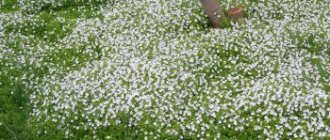The colony of greenish-black insects on the plant is hard to miss. Aphids on orchids, as well as on other indoor flowers, reproduce according to the principle of geometric progression. One adult female is capable of producing from 60 to 100 larvae per day, so the fight against this pest cannot be postponed until tomorrow. How to save an orchid from aphids?
Aphids belong to the order of hemipteran insects, numbering about 4 thousand species, of which about 1 thousand varieties are found in Europe. Most of them are malicious pests of plants, capable of not only destroying them by sucking out the juices, but also carrying dangerous viral diseases and causing various gall-shaped growths.
Where can aphids appear on orchids?
Naturally, this harmful insect is not initially found in apartments, but it can get into the room in several ways. They are obvious:
- any small parasite can be carried into the house by the wind through a window or balcony opening;
- you can bring the pest yourself on clothes or shoes;
- traditional carriers of harmful insects are pets after a walk;
- it is quite possible to buy an already infected plant in a store;
- aphids can spread to the orchid from neighboring indoor plants;
- If you collect soil on the street and do not disinfect it, the likelihood of aphids getting into the apartment along with the substrate is very high.
The most effective fight against this parasite is carried out at the initial stage of infection. But it is precisely at this time that the aphid, when its colony is still small, is difficult to notice with the naked eye.
Main signs of damage
An experienced orchid owner always carefully examines the flower in order to promptly notice signs of damage. Symptoms of infection are as follows:
- the presence of aphid colonies on the leaf plate;
- stems and leaves are limp, twisted;
- the stem may darken over time;
- drying out of the peduncle;
- deformation of buds.
If the pest has been affecting the orchid for a long time, it may not bloom well or may not begin to bloom at all.
Insect species
There are about 4,000 species of aphids in nature. The main ones:
- Brown. She is also called the ashtray. He especially loves pears, but he won’t refuse orchids either. Able to survive in any climate.
- Green. This is also mainly a garden pest that affects fruit trees, but if you have an orchid growing in your dacha, prepare to encounter this species as well.
- Black. It looks smaller than the others, but it can cause damage much faster and more due to the large number of colonies.
- Yellow. A relatively harmless and primitive species, it rarely migrates; only one generation of insects is born per season.
- Red. It severely affects the roots of the plant, forming growths on them, which then crack and rot.
- White. The most common and dangerous because it is difficult to notice even in large numbers. The species constantly migrates, so it can be found almost everywhere.
Risk factors
The mealybug attacks weakened plants, while practically not attacking healthy ones. Infection of orchids occurs when there is a metabolic disorder in the plant. There may be two reasons for this:
- excessive fertilization of the plant;
- improper living conditions - lack of light and dry air (which is typical for urban housing in winter).
In both cases, the composition of the plant sap changes, making it vulnerable to the pest.
Healthy! The optimal temperature for the reproduction and development of these beetles ranges from 24-25°C, so heat-loving orchid species are more likely to become their victims.
What does the affected plant look like?
If the plant is severely affected, it is immediately noticeable:
- leaves become soft and limp;
- at the final stage of infection they begin to curl;
- the bud also becomes sluggish, eventually dries and falls off;
- the flower stalks also dry out;
- The stem begins to noticeably darken.
Important! At the earliest stage of infection, a sticky coating appears on the underside of the leaves. Therefore, the orchid must be examined regularly.
Aphids begin to attack the plant from the leaves. Then the insect gradually moves onto the stem, peduncles and, finally, onto the flowers themselves. Flower juice is the most desirable delicacy for them. When feeding, aphids not only draw juices from the plant, depleting it, but the insects’ saliva secretes poison that can destroy the orchid.
Consequences of the appearance
First, the insect parasitizes on the leaves, after which it moves to the stems and buds , since these parts of the plant are the juiciest. Aphids from it receive useful microelements that are necessary for the plant itself so that it can develop normally.
These insects reproduce very quickly. They densely cover the places where new shoots should grow.
While feeding, aphids secrete toxic substances into the plant . Because of this, the orchid’s processes of photosynthesis and delivery of nutrients to all parts are disrupted. The affected areas gradually become soft, after which they may die. If measures are not taken in time, the parasite will destroy the flower.
How to get rid of white aphids?
Fortunately, there are quite a few methods and means to combat these pests. You just need to not be too lazy to use them on time.
Mechanical method
To combat aphids, it is most effective to use appropriate preparations - there are quite a lot of them in stores. As a rule, if the gardener has not yet encountered this problem, there are no such remedies at hand. And help should be provided to the plant as quickly as possible.
In such cases, a simple method of pest control, called mechanical, will help. The following actions must be taken:
- collect spotted individuals and their larvae by hand and destroy them;
- rinse the flower thoroughly with warm water;
- It is advisable to use a soap solution.
Important! Water should not get into the axils of the leaves. It stagnates there and causes the plant to rot, which is especially attractive to pests.
After the procedure, the soil must also be disinfected. To do this, you need to lightly stir it and pour it with a solution of potassium permanganate.
Biological drugs
The latest invention to combat such pests. Insects are destroyed by a special type of bacteria, although not immediately, but gradually, over approximately one week.
The advantages of this method include:
- availability of spraying treatment;
- protective properties last up to 2 weeks;
- These drugs do not cause any harm to humans or pets.
Important! There is one drawback to biological drugs. Do not allow preparations of this type to come into direct contact with the flower: it may die.
Spraying is carried out from the bottom up starting from the leaves. The leaves are treated on both sides, and only then the solution is applied to the stem.
The most effective and widespread biological products include:
- Fitoverm - its effect begins after approximately 2 days and lasts up to 3 weeks;
- Entobacterin - starts working after 5 days, is especially effective at temperatures around +30 degrees;
- Confidor - the drug is produced in Germany and is highly effective; its effectiveness is noticeable a week after treatment;
- Akarin - also shows good results after a week, but does not work on all types of aphids.
It is advisable to duplicate the initial treatment after 2-3 weeks, then the result will be better. It is only important to strictly follow the instructions for use of the drug.
Chemicals
They are recommended for use in cases of severe infection. For greater effectiveness, solutions of this type should be used at intervals of 2 weeks.
Important! It is advisable to use the drugs alternately. They quickly become addictive to insects and cease to have a detrimental effect on them.
When treating plants with chemicals, be sure to use rubber gloves and a respirator. The procedure must be carried out outdoors.
There are several available and effective drugs:
- Aktara - acts on the nerve endings of the insect and leads to its almost instant death;
- Actellik - actively acts not only on the plant, but also in the soil, begins to destroy insects already in the process of spraying;
- Spark is one of the rare chemicals that is virtually harmless to humans and pets;
- Intavir disrupts the functioning of the nervous system of pests, causing them to quickly die.
According to the method of influencing parasites, chemicals are divided into several groups:
- intestinal enter the insect’s body through the juice of the treated plant;
- systemic ones kill aphids when they enter the intestines and directly onto the skin;
- contact ones act by contacting the insect itself.
It is believed that systemic and intestinal remedies are most effective. Contact ones are recommended to be used at the initial stage of infection.
Shchitovka
The scale insect that attacks phalaenopsis is a rapidly reproducing species of parasite and it usually appears on weak plants that are overfed with nitrogen. An insect can be of various types:
- palm scale;
- soft false scale;
- hemispherical pseudoscutellum.
These insects reproduce sexually and asexually, depending on the species. Male individuals can move from plant to plant, female individuals stick to the leaves with the help of a proboscis, feed on its juices and lay up to 2000 eggs. After the death of the mother, the larvae quickly spread to other plants.
Treatment
Treatment of scale insects is quite complicated, but possible. The natural enemy of the scale insect is good lighting and high environmental humidity. Therefore, in order to avoid the spread of the parasite, you should not just isolate the phalaenopsis, but even better, place it in a greenhouse.
Experienced gardeners recommend keeping the orchid in a greenhouse for 2-3 days, until the adults die and the young ones crawl out from under the mother’s shield. Next, we take the orchid out of the greenhouse and rinse it well under warm, running water, thus washing away the young insects.
Among the folk methods, the method of treating leaves with garlic pulp, as well as a soap-alcohol solution, has proven itself well.
However, here you should act with the utmost caution and apply these products exclusively to areas affected by scale insects
Chemical preparations for the treatment of scale insects have also proven themselves to be excellent:
- Contact insecticides: Permethrin.
- Intestinal: Aktara, Actellik, Arrivo.
- Systemic: Methylmercaptophos, Phosfamide.
Is it possible to fight pests with folk remedies?
There are a lot of folk remedies for fighting aphids, and most of them are quite affordable. However, at a late stage of the lesion they are not always effective.
Here are some of them:
- Garlic. The bulbs are crushed together with the husks and dissolved in warm soapy water, the product is infused for a day, after which it is sprayed.
- White mustard. 10 g of mustard is dissolved in 1 liter of warm water and left for two days, the resulting concentrate is diluted with water in a ratio of 4:1.
- Tomato tops. 0.5 kg of tops is poured into 1 liter of water, boiled for 30 minutes and, after cooling, sprayed on the affected plant with added soap.
- Nettle. It is crushed, filled with water and infused for about a day.
- Bulb onions. It is cut together with the husk, filled with water and left for about 8 hours, before use it is filtered and then sprayed on the orchids.
- Citrus peels. They are also filled with water, left for 3 days and sprayed several times.
- Alcohol. The soap solution is mixed with alcohol in equal proportions; 15 minutes after the spraying procedure, the leaves are washed with water so that they do not burn.
Some gardeners successfully fight aphids using the medicine Trichopolum. The tablet is dissolved in water and sprayed on the plants. You can bury such a tablet in the ground before planting an orchid; it is believed that this will be a preventive measure against many pests.
Ways to fight
So, what to do if insects are found on the leaves? First of all, isolate the orchid from other flowers. Otherwise, you risk infecting aphids and other indoor plants. After this, you need to remove the flowers and buds (insects can hide between the petals and inside the bud), wash the leaves and remaining flower cuttings with water. This will rid the plant of the vast majority of uninvited guests. After this, regular therapeutic and preventive measures are necessary.
You can control pests at home using folk remedies or chemical compounds. If the aphid colony has not managed to occupy the entire flower, the use of chemicals is not recommended. In this case, you can achieve a good result using “grandmother’s” recipes, the components of which are of natural origin and do not harm the health of either the orchid or humans.
Soap solution
To prepare the solution you will need ordinary laundry soap (without any fragrances or coloring additives!) and water. Dilute 1 tablespoon of soap crumbs in 1 liter of water (soap can be cut with a knife). Using a sponge, treat the leaves and stems of the plant, previously washed with plain water and inspected, with soapy foam.
Citrus infusion
It will take three days to prepare the composition. For the infusion, you need to prepare the peels of a citrus fruit (orange, lemon, etc.). 100 g of dried peels are poured into 1 liter of boiling water. Afterwards everything is mixed and the composition is left to infuse. After 3 days, the infusion can be used to spray the affected plant. Leaves and stems need to be sprayed every 5 hours. To enhance the effect, dry citrus fruit peels are laid on top of the soil.
Onion water
How to fight pests with onion water? Very simple and inexpensive! Chop 1 large onion, pour 1 liter of boiling water over the product and let cool. Strain the mixture through a sieve and pour into the sprayer. Irrigate the orchid with onion water several times a day until the insects disappear completely.
Essential oils
Important! It is not recommended to use oil solutions at temperatures above +25C and high humidity!
Peppermint or tea tree oil is suitable for preparing the composition. Dissolve 10-20 drops of oil in 300 ml of water and wipe the leaves.
How to treat the soil and roots?
It is recommended to periodically, even for preventive purposes, water the plant with a solution of potassium permanganate, but if it becomes infected, this must be done. You can water the soil in the pot with a solution of biological preparations, but you should not treat the roots with chemicals. An infusion of onion peels helps a lot.
It happens that when orchids are transplanted, characteristic growths caused by aphid infestation are found on the roots. They must be removed immediately and the entire plant disinfected.
Photo
Below in the photo you will see what the most common white aphid and other varieties of the parasite look like.
Preventing the spread of aphids
There are several simple steps that will help prevent aphid infestations:
- the orchid should be watered regularly, once a week, no more and no less;
- dry soil attracts aphids, but also abundant moisture on the leaves - do not allow either one or the other;
- excess or lack of fertilizers significantly weakens the plant’s immunity - watch this and follow the dosage and frequency indicated on the label;
- pots must be disinfected before use;
- soil, even purchased in a store, should be kept in the freezer or oven for a while before planting: this procedure will destroy possible pests and their larvae.
Preventive action
Fighting aphids is an activity that requires painstaking action.
Therefore, it is worth paying attention to prevention and then pest attacks on the orchid can be avoided. There are several points that owners of this flower need to know about:. Humidity
The recommended value is 60%. This indicator is pleasant for humans and indoor plants. And aphids prefer dry climates. Watering. It must be done in such a way as to avoid the accumulation of liquid drops in the leaves and buds. It is recommended to combine root watering with spraying with cool water. Feeding. The right choice of fertilizers will give the orchid the strength to resist diseases and pests. However, excess nutrients (eg nitrogen) can have the opposite effect
Humidity. The recommended value is 60%. This indicator is pleasant for humans and indoor plants. And aphids prefer dry climates. Watering. It must be done in such a way as to avoid the accumulation of liquid drops in the leaves and buds. It is recommended to combine root watering with spraying with cool water. Feeding. The right choice of fertilizers will give the orchid the strength to resist diseases and pests. However, excess nutrients (eg nitrogen) can have the opposite effect
It is important to follow the dosage. A solution of Neem tree oil (10–20 drops) in water (300 ml) gives a good effect against all insects. It is used for spraying. If, despite all efforts, the first signs of aphid damage appear, then measures must be taken immediately. This will give you a better chance of winning a complete victory over it before the colony grows.
This will give more chances to achieve a complete victory over it before the colony grows.
Oil from the fruits of the Neem tree is an excellent aphid prevention
General preventive measures
For house plants:
- Weak flowers are most susceptible to attack by parasites.
- It is necessary to promptly remove dry leaves and yellowed stems.
- New flowers must be quarantined.
- Do not overfeed the plants.
- Be sure to get rid of ants and choose planting sites with diffused light.
- Before planting in a new pot, the flower must be sterilized.
- Twice a week, inspect all plants in the house and regularly rinse them with running water.
For garden flowers:
- Systematically remove weeds.
- During the summer, destroy anthills. This must be done, since ants protect aphids in every possible way and even bring them into the garden themselves (read more about the symbiosis of these insects here).
- In the spring, carry out sanitary pruning of all plants.
- Before buds begin to bloom, spray fruit trees and flower stems with insect repellent.
- Do not overfeed plants with nitrogen.
- Wash plants with a hose.


